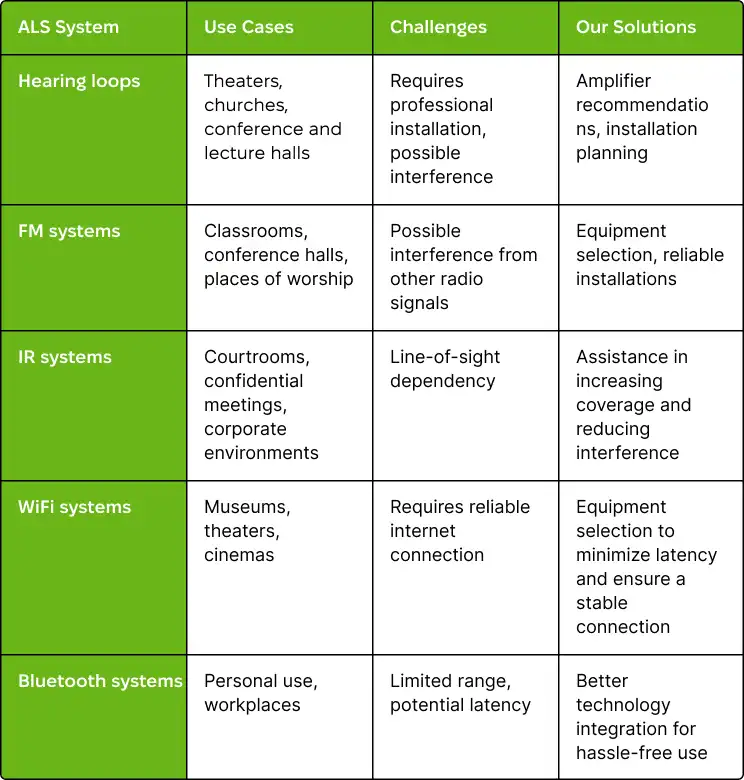Interested in how assistive listening solutions work in practice?
Explore our case study.
Published: 7 April, 2025 · 6 mins read
Avoid ALS implementation failures by choosing the right solution. Explore assistive listening system types, use cases, and expert-backed accessibility strategies.
Enhancing Accessibility: Developing Assistive Listening Solutions
Did you know that
40% of adults
aged 20 to 79 in Canada experience at least slight hearing loss in one or both ears? Hearing loss affects millions, yet assistive listening solutions are still underutilized.
Now, you may be wondering: What is assistive listening in the first place? It’s a set of technologies that help people with hearing loss hear more clearly. As the UN Sustainable Development Group
points out, these solutions promote inclusion, especially in educational and working settings. Besides, every $1 invested in assistive tech generates $9 in social and economic benefits.
Having worked with assistive technology solutions, we’ve seen their impact firsthand. For example, our client struggled with an outdated, poorly designed app for assistive tech installations. We tackled that by building a modern
platform for assistive listening solutions, which put our client ahead of the competition.
Read on to discover the main types of assistive listening systems, ways to choose the best ones, and why they’re worth your investment.
Key takeaways:
Explore our case study.
Assistive listening systems (ALS) may take various forms and have different use cases. Let’s clarify each type.
Based on the core technology used, assistive listening products divide into the following kinds:
Assistive listening can be used to improve accessibility in various settings:
To make things a bit clearer, here’s a brief comparison table:
| ALS System | Use Cases | Challenges | Our Solutions |
|---|---|---|---|
| Hearing loops | Theaters, churches, conference and lecture halls | Requires professional installation, possible interference | Amplifier recommendations, installation planning |
| FM systems | Classrooms, conference halls, places of worship | Possible interference from other radio signals | Equipment selection, reliable installations |
| IR systems | Courtrooms, confidential meetings, corporate environments | Line-of-sight dependency | Assistance in increasing coverage and reducing interference |
| WiFi systems | Museums, theaters, cinemas | Requires reliable internet connection | Equipment selection to minimize latency and ensure a stable connection |
| Bluetooth systems | Personal use, workplaces | Limited range, potential latency | Better technology integration for hassle-free use |

Now that you know the main types of assistive listening technologies and their typical use cases, you may be thinking about how to choose the right one. Let’s figure this out.
Before picking an ALS, consider the following factors:
Besides the above considerations, keep the following challenges in mind:
«Implementing assistive listening solutions isn’t just about plugging in devices. It’s about considering technical and user-specific needs along with your space, budget, and privacy constraints.»
In case you’re still unsure which ALS matches your processes, here are the most commonly asked questions on such solutions:
Request a consultation from Exoft!
Exoft has been in the software development industry for over 10 years and, during this time, we delivered plenty of assistive technology software solutions. Here are two of our most impactful projects:
One of our clients, a leader in assistive listening solutions for 50+ years, needed
a modern web portal
to design and manage assistive tech installations. Their previous application, though functional, suffered from poor UI/UX, slow performance, and frequent errors.
As a solution, we handled:
Ultimately, our healthcare app development process helped our client surpass the competition in just a year.
A rehabilitation center approached us to digitize their psychological support framework for veterans. They were struggling with manual processes, paper-based records, and security concerns.
To tackle the challenges, we developed a
digital solution for a veteran rehabilitation center
that comprised a web platform and one of the
top healthcare mobile apps. Together, these elements digitized the psychological support process and enabled hassle-free coordination for veterans, their families, and medical staff.
Now, let’s reiterate the importance of adaptive software. Here’s how ALS improves accessibility in different settings:

Assistive listening software development and device installation is a way to create truly inclusive spaces where everyone can engage fully. Whether you run a theater, an office, or a healthcare facility, ALS offers plenty of benefits. Here’s why it’s worth the investment:
«With the rising demand for accessibility, venues and businesses must adapt. Assistive listening solutions aren’t an option anymore. They are critical for creating inclusive experiences for all.»
Get in touch with us to come up with a solution that fits your goals.
Implementing customizable assistive listening solutions requires the right strategy, technical assessment, and engineering expertise. That’s precisely what we offer at Exoft. In particular, our services include:
On top of the flexible services we provide, our specialists have proven expertise in healthcare and accessibility software. They can pick up a suitable ALS tech stack and build performant, intuitive solutions that truly improve assistive listening experiences.
Request a project estimation today!
We’ve covered a lot of ground, but the core message is simple: assistive listening solutions are essential for creating accessible spaces. They go beyond just amplifying sound — they amplify opportunities.
What are the basic assistive listening devices (ALDs) you can use to make your space more inclusive? You can use any model, from hearing loops and WiFi-based audio to FM, IR, and Bluetooth systems. You can even increase your impact with AI-enabled assistive technology — smart systems that use algorithms to filter out noise and enhance speech.
If you plan to implement an ALS solution, count on Exoft. With a 10-year background and expertise in assistive tech, we can make sure that no one is left out of the conversation.
Let’s discuss all your project stages in detail!